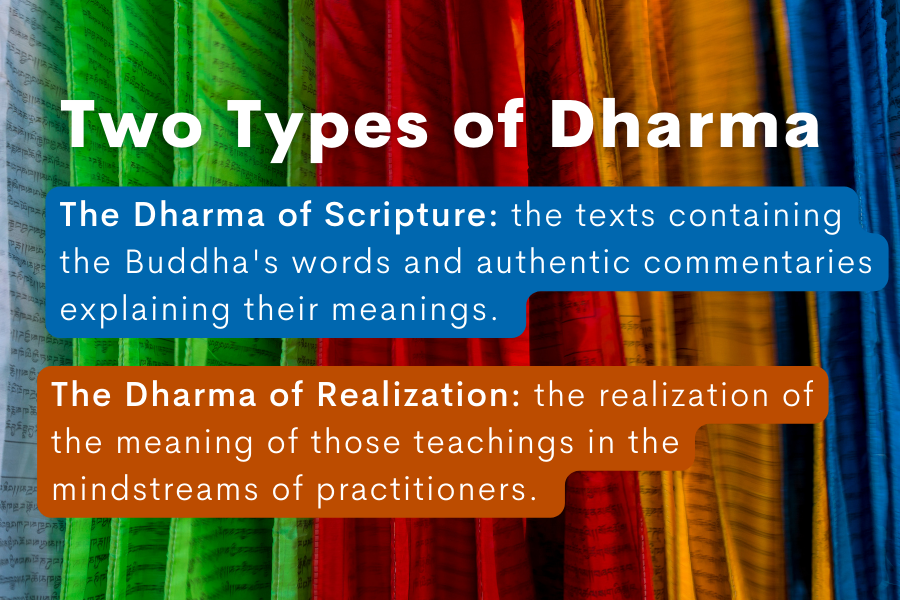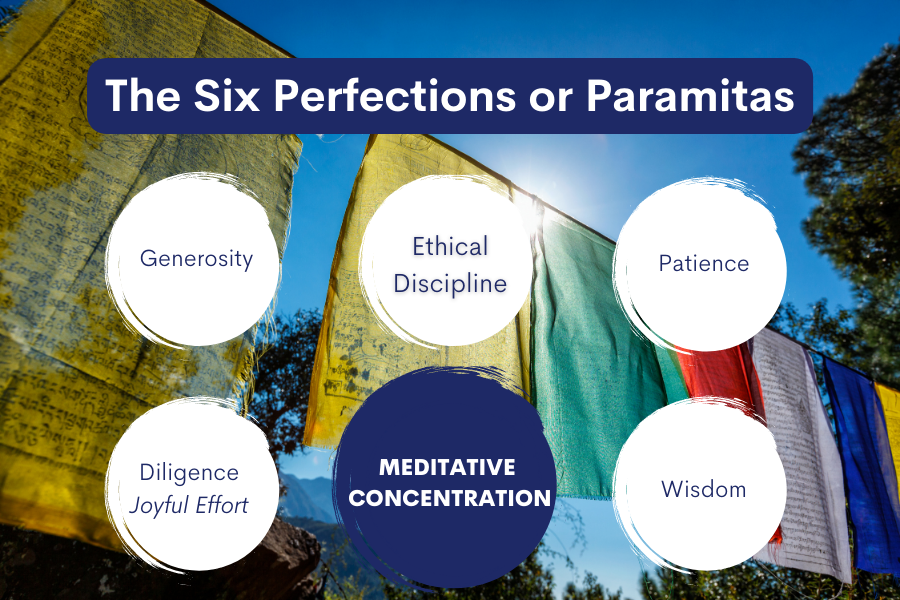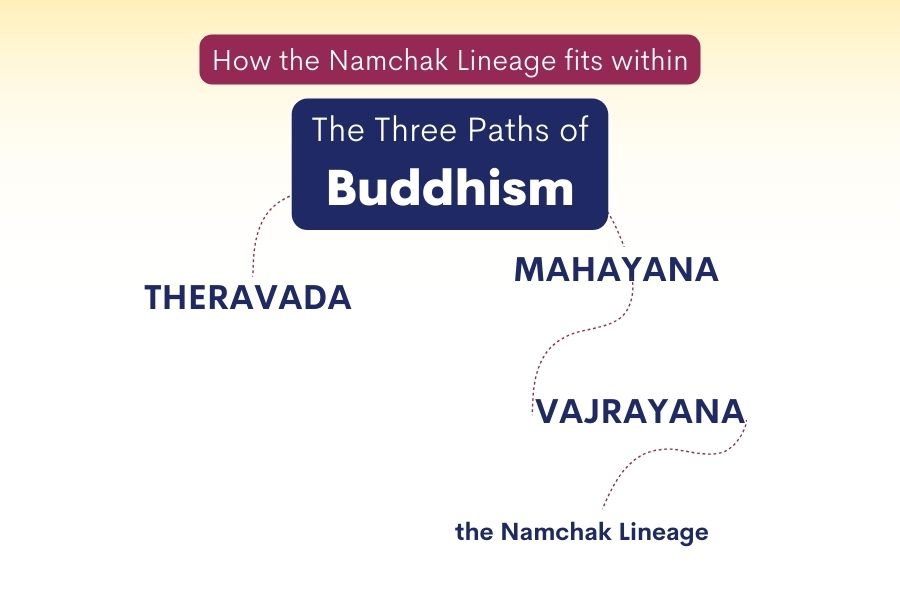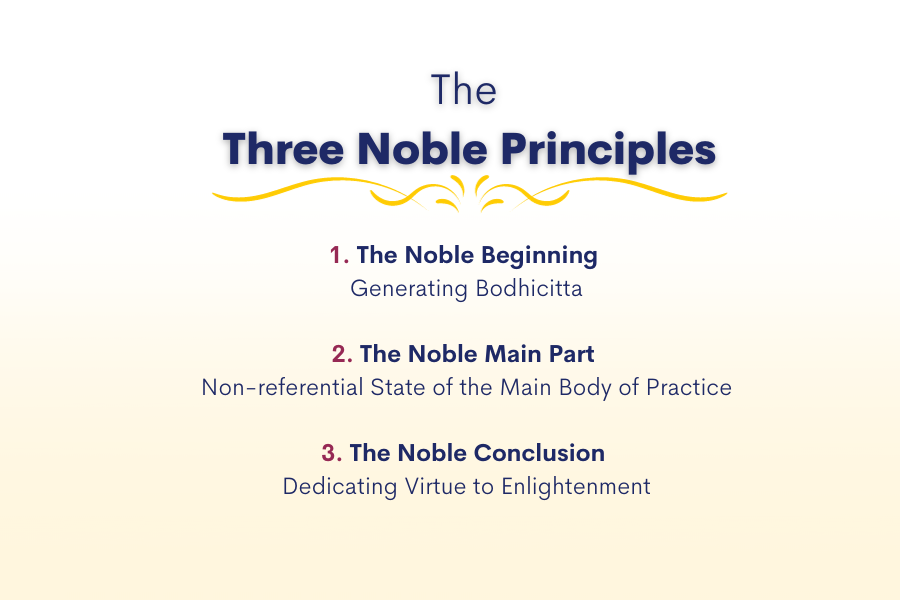Wisdom, or sublime intelligence, is to know reality as it really is and is what makes the other five become Perfections The post Practicing the Perfection of Wisdom appeared first on Namchak Tibetan Buddhist Practice & Retreat.
Welcome back to our series on the Six Perfections or Six Paramitas of Buddhism!
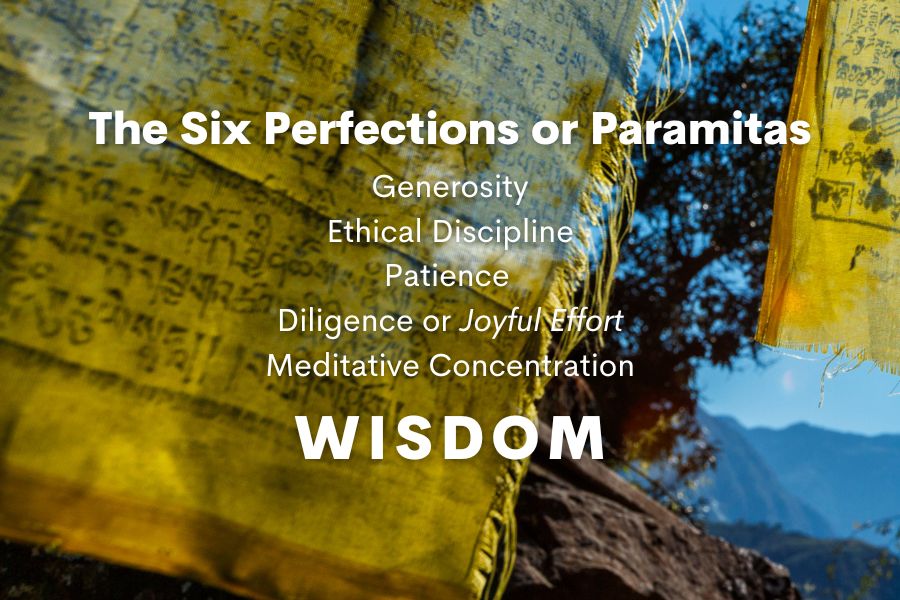
Get started with this Dharma talk by teacher and Tibetan Translator Justin Kirkwood.
He explores the Perfection of Wisdom in this August 2023 One Community Sangha gathering recording.
What is Wisdom?
Wisdom, or sublime intelligence, is to know reality as it really is and is what makes the other five become Perfections. To know the world around us precisely as it is may sound simple to accept intellectually, but it isn’t the way our minds typically grasp things. We tend to think that objects or people are what they are, in and of themselves. This tendency can be problematic in a world full of impermanence. For example, let’s say we assume that one of our friends is always going to be a certain way. Inevitably, they will change. That shift will be difficult for us if we grasp how they once existed.
But even in that moment we’re talking about, when we perceived our friend, did we “know” them in some ultimate way—their ultimate nature? Why, then, do others, even in that moment, perceive something else?
What does it mean to cultivate Wisdom?
The Perfection of Wisdom is the realization of emptiness—the ultimate nature of all things. The word “realization” makes it sound like something that can happen in a single moment. Don’t be fooled–that is almost never the case! Emptiness is a vast topic. The realization of emptiness takes time, as well as regular practice of Shamata and Vipassana.
Here are some tips from the book “Deepening Wisdom, Deepening Connection” by Lama Tsomo on how to begin cultivating the Perfection of Wisdom.
“I spoke of these three in Book 2: hear, contemplate, and meditate. These as a whole will bring us Transcendent Wisdom. If we’re missing any of those pieces, it will be difficult for us to gain much wisdom. Of course, we need to begin the cycle with instruction. Why reinvent the wheel? If there is a qualified teacher who can transmit information that has successfully led people to liberation, why try to figure it out for yourself? But it’s not enough to hear the words.
“Without asking questions and seeing how these concepts actually work in your mind and your life, you aren’t digesting what you’ve taken in. Remember, the Buddha didn’t think much of blind faith. He was a big proponent of a well-examined faith because then it can become the faith of knowing for yourself. So contemplation is the natural next part of the cycle. The final step to the faith of knowing for yourself is what comes from our actual experience.
“The word for practice in Tibetan is nyam-len, which means ‘gain experience.’ For those who would like to learn strictly from experience, I would remind them that without instruction, they can’t use the mind-training tools properly, and they won’t gain the intended experience. So two more truths: we need expert instruction, and we need to apply that instruction through ardent and sustained practice.
“It really takes all three of these—hearing, contemplation, and meditation—to arrive at Transcendent Wisdom. One practice that obviously helps us with Transcendent Wisdom is Vipassana. It’s terribly important to all branches of Buddhism because, of course, we need to be able to see directly into the true nature of our minds, reality, and the relationship between them.
“I find that pursuit fascinating. It’s also essential to apply Transcendent Wisdom to so many of the other qualities we’re cultivating. For example, we’ve talked a bit about compassion without wisdom really being what Chögyam Trungpa Rinpoche calls idiot compassion. So as with all of these Transcendent Perfections, we need a great deal of this one in order to benefit from the others . . . and the Dharma.”
(Excerpt from Ancient Wisdom for Our Times: Tibetan Buddhist Practice: Deepening Wisdom, Deepening Connection, Namchak Publishing Company LLC p 96-97)
Cultivating all of these Perfections is no easy task! This is a lifelong commitment. So, why do we do it? Why set such a large goal for ourselves?
The Six Perfections are some of the main goals of the Mahayana and Vajrayana paths of Buddhism–we focus our motivation on accomplishing the welfare of others, and our own spiritual progress is greatly enhanced by the power of that motivation of love and compassion. When we lose our way or struggle to find motivation, we can return to this ultimate goal of cultivating love and compassion for others, and of course, along the way, we cultivate that love and compassion for ourselves.
How can I cultivate Wisdom?
We gain Wisdom with regular practice of Shamata and Vipassana or Insight meditation. In Vipassana, we sink into a deep investigation of how our minds work with well-tested guidance from those who have a great deal of experience.
You’ll want to have your Shamata somewhat stabilized before starting this practice of Vipassana—Sublime Insight. Rinpoche says that Vipassana won’t help much if your mind is wildly unstable. We’re not looking for perfection, but if your mind isn’t at least a little bit settled, Rinpoche likens it to a candle in a windy spot. In other words, it won’t be strong enough for you to do the enlightening part with Vipassana.
How will I know when I am ready for Vipassana practice?
According to Lama Tsomo in “Deepening Wisdom, Deepening Connection,” “One standard that Tibetans often use is to see if the image they’ve been using as their Shamata support appears clearly in their mind’s eye, even when they’re not looking at the image. The other is that your mind doesn’t feel like a waterfall when you’re meditating, more like a slow river; better yet, a great, placid ocean. If that’s the case for you, you’re probably ready for Vipassana.
“Even more than with Shamata, after reading this introduction to Vipassana you’ll find the practice makes a whole lot more sense, and is benefiting you more if you’ve gone to live teachings. Best of all, if you get the chance, do at least a weekend practice retreat. We offer them occasionally, and Insight Meditation Society, Spirit Rock, Tergar, and the Goenka Group offer them all the time. Thousands of people have found them to be life changing.
You can see our upcoming events HERE.
How do I prepare for Vipassana meditation?
“Before you begin Vipassana, ideally you have:
Practiced Round Robin with Shamata pretty much every day for at least six months. Attended a retreat or two to jump-start your practice. Received live instruction from an expert such as Namchak Khen Rinpoche Ngawang Gelek.How do Shamata and Vipassa fit together?
“By now you’ve probably seen how beautifully Shamata pairs with Tonglen or any of the Four Boundless Qualities. You’ve also seen how moving back and forth between them keeps your practice session fresh and alive. There’s something else to be paired with Shamata—even more closely paired. In fact, you practice the two right in the same section of the Round Robin. Yes, Vipassana. They’re designed to go together!
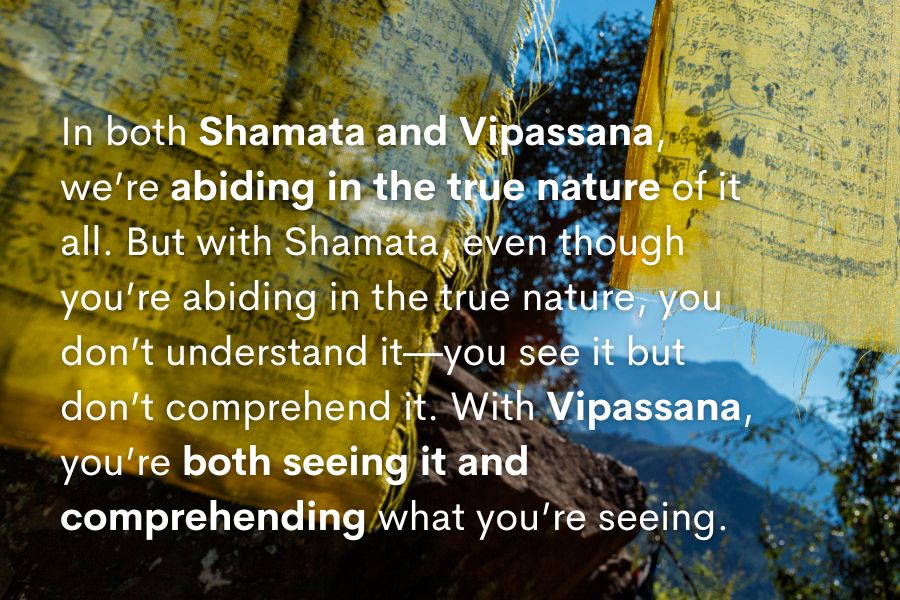
“This brief introduction is meant only to give you a ramp-up to the fascinating and profound understandings that live teachings from an accomplished teacher can give you. Here is my best attempt at condensing Rinpoche’s explanation of Vipassana, as I understood it from a transcript of his live teachings, and my notes at that time and several other times:
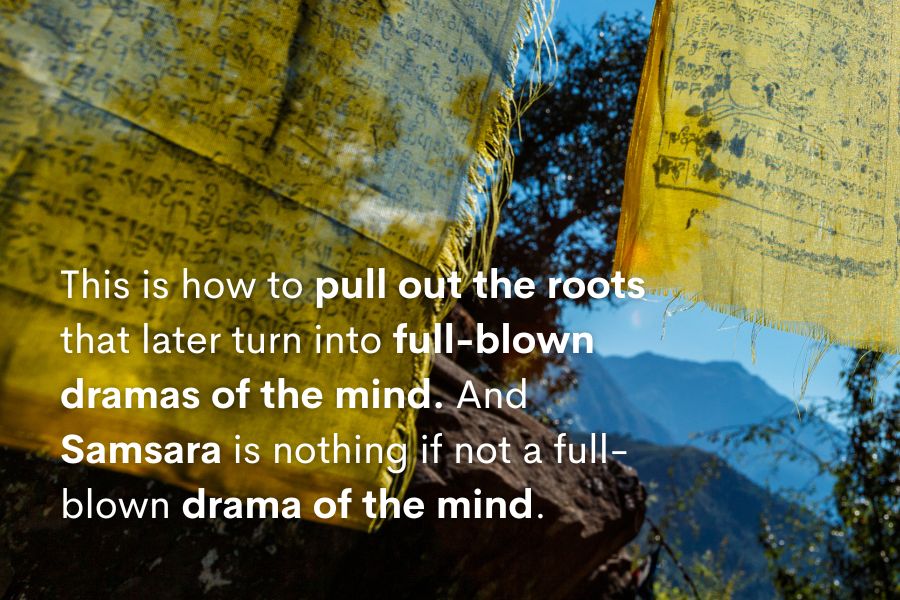
What are the benefits of Shamata or Calm Abiding practice?
“In Shamata, we rest our minds on a non-conceptual image. By ‘non-conceptual image’, he meant that it’s like an image in a mirror: just the plain, simple image, with no thought-commentary like ‘Ooh, this is pretty’, or ‘I don’t like that’, and so on. Just the image. When we’re resting our minds in Shamata, the Three Poisons are temporarily out of the picture.
“To understand the kind of benefit of sitting in this state, Rinpoche likens this to a field after a wildfire has roared over it, burning the grass to the ground. Let’s say the field is crabgrass, a weed I’ve battled a lot in all my years of gardening, because it chokes out all the nutritious plants I’m trying to cultivate. Underneath the ground, the matted crabgrass roots are alive and well, even after the wildfire. After the next rainfall, the entire field is green with new crabgrass shoots. So in Shamata we can sit calmly, with a break in the usually constant flow of thoughts and emotions (well, more or less). But after a short time, the familiar emotions spring up again, at a moment’s notice.
“Once there was a lady behind me in a Shamata retreat, who kept making some kind of scratching noise. I couldn’t figure out what that odd noise was, and I wove back and forth between resting in Shamata and being annoyed. ‘How could she? During a Shamata retreat, no less!’ I thought. I did eventually come to accept it and simply be aware of it like any other noise: the birds chirping, the wind blowing, trees occasionally rustling, the lady mysteriously and annoyingly scratching.
“When the retreat was over, we were allowed to speak, just before we left. I ended up talking to that lady. She turned out to be wise and kind, and grandmotherly, in a refined, intellectual sort of way. I liked her. I indulged my curiosity and asked her what (the heck) that scratching sound was. ‘I’m sorry,’ she said, ‘I’m a poet, and I couldn’t help but try to capture some of the experience in little phrases.’ Later I bought a book of her poems and very much liked them. Since that time I’ve been irritated by thousands of things. They’ve helped my Shamata practice thousands of times.
“Shamata is indeed an essential experience to have and to train in. But in this business of waking up, clearly we need something more. You’ve probably already noticed. Resting our minds on one thing for a bit is not really the same as awakening.
“Back to the field of crabgrass that we’d hoped would be our garden. Clearly, picking the weeds out by the roots would be a more long-lasting solution. So how do we pluck those Afflictive/Neurotic/ Poisonous Emotions out by the roots? This brings us to Vipassana. In Vipassana we actually use the concepts, in order to realize that they have no inherent reality. We look with penetrating insight, right into the quintessence of that very thought/emotion/phenomenon.
“This is how to pull out the roots that later turn into full-blown dramas of the mind. And Samsara is nothing if not a full-blown drama of the mind. As we’ve seen in Shamata, we sign up for the dramas moment by moment, and then keep renewing our subscription. The moments string together into little dramas, the little dramas into big ger ones, the bigger ones giving birth to more little ones, until you’ve spun out a whole lifetime-drama. Then another. Then another.
“Now maybe you see why you might want to get beneath the surface ‘weeds’ and pull the roots out. Now you see the other very important reason to spend time with this practice.
“As for the first answer—the adventure of investigating the mind and reality—scientists are great adventurers, on a lifelong journey of exploration, investigating how the universe works. The scientists at Mind And Life (with His Holiness the Dalai Lama) were intrigued to embark on the inner investigation of Vipassana, but as I’d mentioned before, they were wary of using the observer’s mind as the investigative instrument. Instead of working with objective experience, they would have to use subjective experience. That’s a huge no-no in Western science.
“Not only that, but the item they would be investigating was often that mind, itself, making the whole enterprise potentially circular and solipsistic. (As songwriter Harold Rome asked, ‘Who’s gonna investigate the man who investigates the man who investigates me?’) But quantum physicists (and many others) will willingly admit that it’s actually impossible to eliminate the observer as a factor in the experiments. The Buddha developed methods that would hone the observer’s mind sufficiently to render it a worthy investigative tool. The scientists decided to give this unprecedented (in their experience) approach a try and did a 10-day Vipassana retreat.
“In Wisdom & Compassion (Starting with Yourself), I mentioned that psychiatrist Daniel Siegel writes a hysterical and inspiring rendition of his own experience at that retreat. Since he had never done retreat before, he started out going stir-crazy. In the middle of the retreat, his mind finally fell into a much more quiet state and he was able to perceive and experience reality utterly differently. It was as though he saw the trees—really saw them—for the first time. He tasted the food as he’d never tasted food before. His mind and heart were steady and open as they had never been before. He and the other scientists decided they wanted a steady diet of this training.
“How about you?
“Rinpoche put it yet another way. In both Shamata and Vipassana, we’re abiding in the true nature of it all. But with Shamata, even though you’re abiding in the true nature, you don’t understand it—you see it but don’t comprehend it. With Vipassana, you’re both seeing it and comprehending what you’re seeing.”
(Excerpt from Ancient Wisdom for Our Times: Tibetan Buddhist Practice: Deepening Wisdom, Deepening Connection, Namchak Publishing Company LLC p 101-107)
Read more about the stages of Vipassana meditation HERE.
Join Lama Tsomo for a three-minute Shamata and Intro to Insight guided meditation HERE.
The post Practicing the Perfection of Wisdom appeared first on Namchak Tibetan Buddhist Practice & Retreat.





